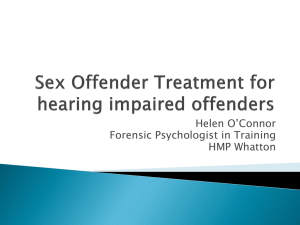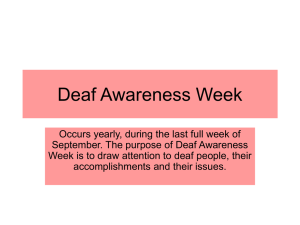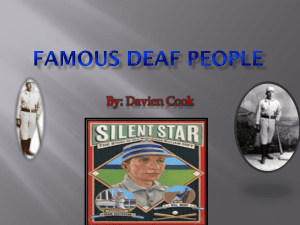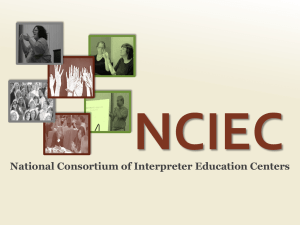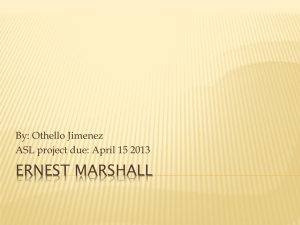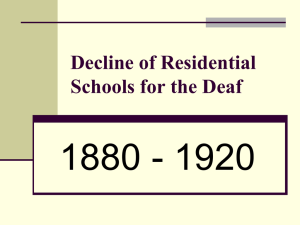National Disability Employment Awareness Month October 2010
advertisement
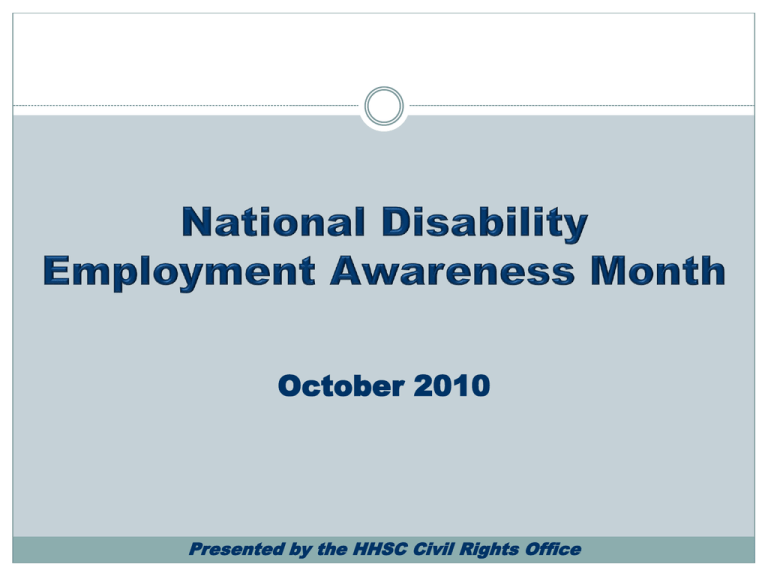
October 2010 Presented by the HHSC Civil Rights Office History of the Observance October is National Disability Employment Awareness Month. The effort to educate the American public about issues related to disability and employment began in 1945 when Congress enacted a law declaring the first week in October National Employ the Physically Handicapped Week. President Harry Truman founded the President’s Committee on the Employment of the Handicapped in 1947 to assist physically disabled veterans in finding employment. In 1962, the word “physically” was removed from the title to acknowledge the employment needs and contributions of individuals with all types of disabilities. In 1988, Congress expanded the week to a month and changed the name to National Disability Employment Awareness Month. Each annual awareness month celebration provides a time to honor our employees, clients, families and friends who have a disability. President Harry Truman Introduction This year, our National Disability Employment Awareness Month presentation profiles 15 Famous People Who are Deaf or Hard of Hearing Michelle Banks Michelle Banks, a native of Washington, D.C., is an award winning actress, writer, director, producer, and teacher. Deaf since age one from spinal meningitis, Banks received her bachelor’s degree in drama studies from the State University of New York. She founded Onyx Theatre Company in New York City, the first Deaf theater company in the United States for people of color. Her first television role was on the popular series "Soul Food." She watched the show during its first season and contacted the executive producer to propose the creation of a Deaf character on the show, a role which she got. Banks is the founder and artistic director of Onyx Theatre, Inc. Her films credits include Malcolm X and Compensation. Her one-woman show, Reflections of a Black Deaf Woman, has toured several cities. She can also be seen in Hilari Scarl’s documentary about the Deaf entertainers, See What I’m Saying. Banks credits Jadolphus CW Fraser, an independent filmmaker, for introducing her to filmmaking and co-directing his feature debut, Always Chasing Love. Banks is an active member of the National Black Deaf Advocates (NBDA). Linda Bove Born in 1945 to Deaf parents, Linda Bove is a famous actress who has a hearing disability. She is mainly remembered for her role as Linda the Librarian on Sesame Street which began in 1971. She brought American Sign Language to the world through the show and her books. Her role on Sesame Street continued until 2003, and it is the longest running role in television history for a Deaf person. Bove was in the soap opera Search for Tomorrow in the 1970s and was Fonzie's girlfriend in 1980 on Happy Days. More recently, she has been involved with the Non-Traditional Casting Project, a non-profit organization that helps people of different ethnicities and handicaps get into the television, performance, and film industry. In 1991, Bove and her husband founded DeafWest Theater, a theater for the Deaf in Los Angeles. She is such an inspiration for all Deaf actors and actresses. Despite being in an industry run primarily by hearing people, Bove retained her culture and her values. She always used sign language and successfully introduced the Deaf and Deaf Culture to families across the country. Bernard Bragg Bernard Bragg is an accomplished performer, writer, director, poet, and artist. Born in 1928, he became interested in theater at an early age and he studied it at Gallaudet University. After graduation he began teaching at the California School for the Deaf (CSD), where he spent the next fifteen years. In 1956 he met the internationally renowned mime Marcel Marceau and he was invited to France to study under Marceau. After he returned, Bragg continued working at CSD, but began to perform mime more and more throughout the U.S. and Europe. In 1967 he left CSD to help found the National Theater of the Deaf. NBC offered to film an hour-long program featuring Deaf performers, which became a historic program as it was the first time Deaf performers used sign language on television. Bragg spent ten years with the National Theater of the Deaf. In 1977 he began an international tour demonstrating the use of sign-mime. He taught at National Technical Institute for the Deaf, wrote plays and began directing. In 1989 his autobiography was published. Bragg continues to lecture, write, consult, and perform nationally today. Andrew Foster Andrew Foster was born in Alabama in 1925, and at an early age he lost his hearing because of spinal meningitis. He attended to Gallaudet University in Washington D.C. where he was the first Black student to be admitted and to graduate from the university. While attending college in Washington, he worked with the inner city Deaf kids. In 1957 he began missionary work in Africa for Deaf children. The cultures in most of Africa were so oppressive of Deaf people that parents often hid or abandoned their Deaf children. Even hearing missionaries told Foster that Deaf children didn't exist in Africa. But he found the children and established schools for them—31 schools in all during his lifetime. For much of his life he spent six months of the year in Africa establishing schools and the other six months in the U.S. raising money to support these schools. In 1970, Gallaudet University awarded him a Doctoral degree, making him the first Black person to receive such degree from this university. Foster trained many teachers and continued his missionary work as more schools opened. Foster met his untimely death in a plane crash in 1987 and the Black Deaf community lost an extraordinary leader. Patrick Graybill Patrick Graybill is a well-known international actor, director, teacher and an American Sign Language (ASL) role model. Renowned for his acting work with the National Theatre of the Deaf, he has worked as a consultant, theater director, actor and teacher at Rochester Institute of Technology and its National Technical Institute for the Deaf Performing Arts Program. He earned a bachelor's degree in English and a master's degree in Deaf education from Gallaudet University. After graduation he taught at the Kendall School for the Deaf, but he wanted to teach literature and theater using ASL, which was not the accepted practice at the time. Graybill decided to enter the seminary, but his pursuit of priesthood was put on hold when he joined the National Theatre of the Deaf in 1969. In between his numerous acting roles and directing and teaching assignments Graybill completed studies for his diaconate, and he has been deacon for 25 years. He has been a college professor for 23 years and a professional actor, guest actor, director and consultant for more than 31 years. He is active in the Deaf Catholic community, and he provides workshops for clergy and students. In 1999 he taught others how to translate mass into ASL, even though the Vatican has not given approval for ASL to be used as a liturgical language. Monique Holt Monique Holt is an actress, poet and storyteller. She is the author of The Night Was so Hungry That it Ate the Moon, a play she wrote because she needed a simple story for her kindergarten students to perform when she was the Artist-InResidence at Fanwood School for the Deaf. The story, a myth about the changing moon, was performed completely in action without any words. Holt first caught the theatrical bug from watching a PBS production of Swan Lake when she was a young child. She finally got her chance to perform at Model Secondary School for the Deaf in her freshman year. She earned a bachelor’s degree in acting from Tisch School of the Arts at New York University. Her training is mostly in acting, physical movement, and modern dance. She was taught herself how to translating from English text into American Sign Language (ASL) and langue des signes française or LSF (sign language of the Deaf used in France). Most of her work entails acting in a variety of roles, translating from English text to ASL (especially Shakespearean plays), creating original poems, adapting Asian folktales, directing plays, instructing students in theater and the acting business, and advocating for Deaf artists. William Hoy Hoy was born in 1862 and at three years old, he lost his hearing from meningitis. He enjoyed a long and successful career in baseball: 18 seasons on professional teams, including 5 with the Cincinnati Red Stockings. He was one of the few players to have played in 4 of the 5 recognized major leagues: The National League, the short-lived Players’ League, the original American Association, and the American League. Hoy taught his teammates how to communicate in sign language—very useful on the field. Many sources say that Hoy played a pioneering role in the creation of the hand signals still used today in baseball. When he began his career, all umpires’ calls were shouted, and Hoy had to ask his coach what the call was. He wrote a request to the third-base coach, asking him to raise his left arm to indicate a ball, and his right arm for a strike. Thus, the intricate system of baseball hand signals—the umpire’s signals, manager’s call signals to batters, and the outfielders’ call signals—has been traced to him. After racking up 1,792 games in the major leagues and a .288 lifetime batting average, Hoy finished out his career at age 42. In 1951, Hoy was unanimously voted the first player to be enshrined in the American Athletic Association of the Deaf’s Hall of Fame. He was inducted into the Cincinnati Reds Hall of Fame in 2003. CJ Jones CJ Jones is a producer, director, writer, actor, comedian, musician, and motivational speaker. He has traveled with the National Theatre of the Deaf and toured with Children of a Lesser God on Broadway. He has also appeared on numerous television shows and movies. In addition, Jones can rightly add educator and advocate to his credits. He heads Hands Across Communications to produce events for international Deaf artists to share their talents and receive recognition for their artistic work. The goal is to make their dream come true through performances on stage. When not pursuing these goals, he takes his one-man show on the road. For more than 35 years, Jones has shared his talents with Deaf and hearing schools, events, and universities across the country and around the world. Having appeared on Broadway stage, in television, video, and on the big screen, he has experienced what he calls the “double whammy” of being an actor who is both Deaf and Black. He vigorously spreads the message to students and adults alike, that being different does not mean being less worthwhile. Harold MacGrath Harold MacGrath was an American author and screenwriter who is most famous for writing The Drums Of Jeopardy (1920). Born in 1871, he started his career writing as a reporter for the Syracuse Herald. Many of his short stories and novels were first serialized in such publications as The Saturday Evening Post and Ladies Home Journal. His first novel was Arms and the Woman, published in 1899. In 1912 he became one of the first nationally-known authors to write directly for the movies when he was hired by the American Film Company to do screenplays. The Vengeance That Failed, a black and white silent Western film was MacGrath's first foray into screenwriting. He would go on to adapt a number of his stories and novels for the screen including The Mollycoddle, released in 1920 and starring Douglas Fairbanks. In 1932 he published an article in The Saturday Evening Post titled "The Short Autobiography of a Deaf Man,” in which he told the public how he had struggled early in life because of having a hearing impairment. At a time in history when Deaf people were almost automatically considered to be lacking intelligence, he hid his impairment from his employer and others. MacGrath died in 1932, a few months after the article was published. Marlee Matlin Marlee Matlin was born in 1965 and at 18 months old she caught the German measles, which left her completely deaf in her right ear and 80% deaf in her left ear. She started her acting career at the age of seven. Her first role in a play as an adult was a supporting character in a production of Children of a Lesser God. She was cast in the lead for the film adaptation of that play, and her performance won her the Best Actress Oscar in 1986. She was the first Deaf actress to win an Academy Award and at age 21, she became the youngest recipient of the Best Actress Oscar and one of only four actresses to receive that honor for a film debut. In addition to the Oscar, Matlin was honored by the Hollywood Foreign Press Association with the Golden Globe Award for Best Actress in a Drama. Matlin continues to act and has produced several projects as well. She has also written three novels for children, the first titled Deaf Child Crossing, and is a spokesperson for the National Captioning Institute. Her New York Times Best Selling autobiography, I’ll Scream Later, was published in 2009. Shanny Mow Shanny Mow is an actor, teacher, playwright, and director. Born in 1938 in Stockton, California, he lost his hearing at age of five due to spinal meningitis. He attended Gallaudet College and California State University and has taught academic subjects for ten years at schools for the Deaf in Great Falls, Montana; Santa Fe, New Mexico and Honolulu, Hawaii. He was a member of the National Theater of the Deaf (NTD) acting ensemble and served as NTD’s playwright in residence for numerous years, authoring The Iliad, Play by Play, The Ghost of Chastity Past, Odyssey, Shakespeare Unmasked and Parzival, From the Horse's Mouth, which was performed at the Kennedy Center. Recently he has appeared on Sesame Street. During his artistic career he has written and directed plays for over twenty years. He served as Artistic Director of Fairmount Theatre of the Deaf. Since 1980 he has served as a faculty member for the NTD Professional Theatre School. Shanny also works as a commercial printer, free-lance photographer and research assistant in sign language at the Salk Institute. Angel Ramos Dr. Angel Ramos was the first Deaf Hispanic to receive a doctorate degree from Gallaudet University and is the superintendent at Sequoia School for the Deaf and Hard of Hearing in Arizona. Ramos is president and executive director of the Angel Ramos Foundation and president and CEO of R&R Publishers, a book publishing company. He has taught various subjects at the middle school, high school, and college levels in Texas, Washington, and New York. He has over 35 years experience in Deaf education. In 1994, he founded the National Hispanic Council of the Deaf and Hard of Hearing. He also founded the Spanish Deaf Association of Dallas, Texas, and has been a consultant and board member of dozens of organizations around the country. Ramos has a bachelor’s degree in mathematics from Manhattan College, a master’s degree in education of the Deaf from the State University of New York, a master’s degree in educational administration from California State University, and a Ph.D. in special education administration from Gallaudet University. He is also a member of the National Advisory Group for the National Technical Institute for the Deaf, a college of Rochester Institute of Technology. Johnnie Ray Johnnie Ray’s musical talent was evident at an early age as he could play anything he heard once. When he was 13, he sustained an injury that resulted in a loss of 50% of his hearing. As a young man, Ray moved to Detroit, Michigan, and became the only White performer at the time singing blues at The Flame Show Bar. Hearing aids of the time were not music friendly as they were made for speech, and Ray performed wearing his then cumbersome hearing aid in his left ear. Ray's fantastic gift of communicating emotion in song completely over-shadowed the hearing aid dilemma. His most famous song was "Cry" which hit number one in 1951. Ray was one of the first performers to take the microphone off the stand and roam and run over the entire stage. His performing style included theatrics later associated with rock 'n roll, including beating up his piano and writhing on the floor. Ray officially established the Ray Foundation in 1953 for the hearing impaired; he opened the foundation using the $1,000 fee he earned when he appeared on Ed Sullivan's Toast Of The Town. He performed through the 1980s, and had a huge fan base in the U.K. and Australia. Pete Townshend Pete Townshend, guitarist and principal songwriter for The Who, began noticing that he had hearing damage in the 1970s. The Who was at the forefront of the British musical boom of the 1960s, and Townshend is the driving force behind the group. He is recognized as one of the most visual guitarist of all time. He developed a unique guitar style, a cross between rhythm and lead, which veered from furiously strummed chord patterns and power chords to chromatic scales and delicate arpeggios. On top of this he frequently smashed his guitar into pieces at the end of a performance. In the 1980s The Who temporarily disbanded, and Townshend began performing solo. Long acknowledged as one of the most intelligent and articulate of rock performers, Townshend has run his own book publishing company and worked as an editor at the literary house of Faber & Faber. He has run successful websites and blog sites, and he is always looking at ways of using the Internet to present musico-dramatic works. In 2006 The Who released Endless Wire, the band’s first new album in 24 years. He is presently working on an autobiography due for publication in 2010. Heather Whitestone In 1995, Heather Whitestone became the first woman with a disability to be crowned Miss America in the pageant’s 75-year history. She lost her hearing when she was only 18 months old. She had haemophilus influenzae and was rushed to the hospital where doctors gave her strong antibiotics to save her life; the antibiotics, however, left her with a profound hearing loss. She attended the Central Institute for the Deaf in Missouri, where she learned two grade levels per year and eventually she returned to Alabama to graduate from public high school in 1991. She attended Jacksonville State University and completed in 62 pageants. Since her Miss America win, she has continued to promote awareness of Deaf issues and has written four books including Listening with My Heart and Let God Surprise You. She volunteers for Republican causes and spoke at the party's National Conventions of 1996 and 2000. In 2002 she had surgery to have a cochlear implant placed in her right ear. She is a motivational speaker and lives in the Atlanta area. Conclusion Please join the Civil Rights Office in celebrating the 2010 National Disability Employment Awareness Month and in honoring the contributions people with disabilities make every day as part of our families, our agencies, our state and our nation. If you would like to provide feedback on this presentation or any of the services provided by the HHSC Civil Rights Office, please take our survey here: http://hhscx.hhsc.state.tx.us/Admin/CR/survey/CSS.asp Sources “A Capsule Biography.” http://www.dummyhoy.com/overview/bio.html “About CJ.” CJ Jones Live website: http://www.cjjoneslive.com/about-cj/ “Act One: It All Began on Metropolitan Street…” Life and Works of Bernard Bragg: http://www.bernardbragg.com/biography/ “Act Two: All the World’s A Stage.” Life and Works of Bernard Bragg: http://www.bernardbragg.com/biography/2/ “Act Three: Actor, Writer, Director: Master of Arts.” Life and Works of Bernard Bragg: http://www.bernardbragg.com/biography/3/ Beals, Gerald. “The Biography of Thomas Edison.” www.thomasedison.com “Behind The Scenes: Directors, Playwrights and Set Designer: Shanny Mow.” Opening Stages: A Quarterly Newsletter for People with Disabilities Pursuing Careers in the Performing Arts: September – November 2008 edition. “Biography.” Marlee website: http://www.marleematlinsite.com/lifebio/lifebio.html Bordash, Michael. “Pete Townshend Warns Headphones Cause Hearing Loss.” http://www.internetdj.com/article.php?storyid=724 Carmichael, Pamela. “Dr. Angel Ramos Joins NTID National Advisory Group: Group is Dedicated to Education and Technical Training for Deaf and Hard of Hearing.” RIT website: http://www.rit.edu/news/story.php?id=45660 “Dr. Andrew Foster.” Deaf Is … Culture website: http://www.Deafis.org/culture/celebrities/foster.php “Harold MacGrath.” Wikipedia: http://en.wikipedia.org/wiki/Harold_MacGrath “Heather Whitestone.” Deaf Is … Culture website: http://www.Deafis.org/culture/celebrities/whitestone.php “Heather Whitestone.” Wikipedia: http://en.wikipedia.org/wiki/Heather_Whitestone “History: Pete Townshend.” The Who website: www.thewho.com Sources “In the Spotlight: NBDA Member Michelle Banks Takes on Hollywood.” http://www.nbda.org/spotlights/spotlight_banks.html “Introducing Shanny Mow.” Bell-Ghost webblog: http://bellghost.blogspot.com/2008/02/introductingshanny-mow_19.html “Johnnie Ray Biography.” http://www.johnnieray.com/bio.html Jones, Arthur. “Deaf actor finds his place in the church – Patrick Graybill – Interview.” National Catholic Reporter: Jan 19, 2001. “Linda Bove: Linda the Librarian.” Start ASL website: http://www.start-american-signlanguage.com/linda-bove.html “Marlee Matlin.” Deaf Is … Culture website: http://www.Deafis.org/culture/celebrities/matlin.php Merriman, C.D. “Biography: Harold MacGrath (1871-1932).” http://www.online-literature.com/haroldmacgrath/ “Michelle Banks: Bio.” http://www.michellebanks.com/html/biography.htm “Monique Holt, MFA Adjunct Professor.” Gallaudet University webpage: http://theatrearts.gallaudet.edu/Faculty-Staff/Theatre_Arts/Holt_Monique.html “Programs and Advocacy: Andrew Foster.” National Black Deaf Advocates: http://www.nbda.org/foster.html “RSD Warmly Welcomes our 2009-2010 Deaf Artist-in-Residence Patrick Graybill 02/25/10.” Rochester School for the Deaf: http://www.rsDeaf.org/gallery.asp?n=RSD-Warmly-Welcomes-our2009-2010-Deaf-A&action=view&ID=120 “Visual Playwrights Retreat: Playwrights' Biographies: Monique Holt.” Quest: Arts for Everyone website: http://www.quest4arts.org/company/playwrights.htm “Welcome to Sequoia School for the Deaf and Hard of Hearing.” http://ssdhh.info/
